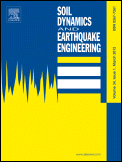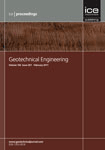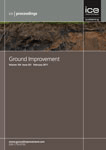
CANADIAN GEOTECHNICAL JOURNAL
Scope & Guideline
Shaping the Future of Civil and Structural Engineering
Introduction
Aims and Scopes
- Soil Mechanics and Behavior:
This area explores the fundamental properties of soils, including their mechanical behavior under various loading conditions. It includes studies on stress-strain relationships, shear strength, and the effects of soil composition and structure. - Geotechnical Engineering Applications:
The journal covers practical applications in geotechnical engineering, such as foundation design, slope stability analysis, and ground improvement techniques, emphasizing real-world case studies and methodologies. - Environmental Geotechnics:
This scope includes the interaction of geotechnical engineering with environmental factors, such as the behavior of soils in contaminated sites, waste management, and the impact of climate change on soil stability. - Numerical and Experimental Modeling:
Research involving numerical simulations and experimental investigations is prominent, focusing on developing models that predict soil behavior under various conditions, including seismic loading and excavation. - Innovative Materials and Techniques:
The journal highlights advancements in materials used in geotechnical applications, including biopolymers, geosynthetics, and innovative construction techniques that enhance performance and sustainability.
Trending and Emerging
- Data-Driven Approaches and Machine Learning:
There is a noticeable increase in the application of data-driven methodologies, including machine learning and artificial intelligence, to predict soil behavior and optimize geotechnical designs, reflecting a trend towards integrating technology in geotechnics. - Sustainable Geotechnical Practices:
Research on sustainable practices, including the use of recycled materials and biopolymers, is gaining momentum. This reflects a broader shift towards environmentally friendly engineering solutions in response to climate change. - Impact of Climate Change on Geotechnical Engineering:
Papers addressing the implications of climate change on soil behavior and geotechnical infrastructure are increasingly prevalent, highlighting the need for adaptive strategies in geotechnical design due to changing environmental conditions. - Advanced Numerical Modeling Techniques:
The use of sophisticated numerical modeling techniques to simulate complex geotechnical problems is on the rise. This includes developments in finite element methods and discrete element modeling, showcasing advancements in computational geotechnics. - Interdisciplinary Research:
There is a growing trend towards interdisciplinary research that combines geotechnical engineering with other fields such as environmental science, structural engineering, and materials science, indicating a broader approach to solving complex geotechnical challenges.
Declining or Waning
- Traditional Soil Testing Methods:
There seems to be a reduction in papers focusing on conventional soil testing methods as newer, more advanced techniques gain popularity and acceptance. The shift towards innovative methodologies may be overshadowing traditional approaches. - Purely Theoretical Studies:
Studies that are heavily theoretical without practical application or case studies have become less prevalent. The journal appears to be moving towards research that integrates theory with real-world applications. - Static Analysis of Foundations:
Research focused solely on static analysis of foundations is declining, as there is a growing emphasis on dynamic analysis and considerations of environmental impacts, such as seismic activity and climate change.
Similar Journals

International Journal of Physical Modelling in Geotechnics
Pioneering insights for sustainable infrastructure solutions.The International Journal of Physical Modelling in Geotechnics, published by Emerald Group Publishing Ltd, is a leading platform dedicated to advancing the field of geotechnical engineering and engineering geology. With a focus on the practical applications of physical modeling, this journal contributes significantly to the understanding of soil and rock behavior under various conditions, making it invaluable for researchers, professionals, and students alike. Heightened by its Q2 ranking in its category and a notable 61st percentile ranking among its peers, this journal has established itself as a credible source of knowledge and innovation within the academic community. Although it does not currently offer open access, its rigorous peer-review standards ensure the dissemination of high-quality research and insights. The journal, covering a timeline of topics from 2011 to 2024, aims to bridge the gap between theory and practice, ultimately fostering advancements in geotechnical solutions necessary for infrastructure development. To stay at the forefront of geotechnical research, contributing authors and engaged readers are encouraged to explore and participate in this dynamic academic discussion.

SOIL DYNAMICS AND EARTHQUAKE ENGINEERING
Bridging Disciplines for a Safer, More Resilient FutureSOIL DYNAMICS AND EARTHQUAKE ENGINEERING is a premier academic journal published by ELSEVIER SCI LTD, focusing on the intersection of civil and structural engineering, geotechnical engineering, and soil science. Since its inception in 1986, the journal has established itself as a critical resource for advancing knowledge in these fields over nearly four decades, with a remarkable Q1 ranking in 2023 across multiple categories, including Civil and Structural Engineering, Geotechnical Engineering, and Soil Science. The journal’s impactful research, reflected in its high Scopus ranks, serves as a vital reference for both professionals and academics dedicated to understanding soil dynamics and mitigating earthquake hazards. Although it currently does not offer open access, the journal's rigorous peer-review process ensures that published articles provide substantial contributions to the understanding of soil behavior under seismic conditions. Whether you are a researcher, a practitioner, or a student, SOIL DYNAMICS AND EARTHQUAKE ENGINEERING offers essential insights and innovative methodologies pivotal for advancing your work in soil dynamics and earthquake engineering.

Geomechanics and Engineering
Empowering Engineers with Cutting-edge ResearchGeomechanics and Engineering is a premier journal published by TECHNO-PRESS that delivers high-quality research in the fields of civil and structural engineering, as well as geotechnical engineering and engineering geology. With an ISSN of 2005-307X and an E-ISSN of 2092-6219, this journal serves as a significant repository of innovative methodologies, case studies, and theoretical advancements. Located in South Korea, Geomechanics and Engineering is indexed in Scopus, where it boasts a commendable ranking of #100 out of 379 in Civil and Structural Engineering and #69 out of 229 in Geotechnical Engineering and Engineering Geology, reflecting its impact with substantial percentile rankings of 73rd and 70th, respectively. Over its converged years from 2009 to 2024, the journal aims to advance the understanding of geomechanical phenomena and their application in engineering, making it an essential read for researchers, professionals, and students committed to solving today's pressing engineering challenges.

Soil Mechanics and Foundation Engineering
Exploring the Depths of Soil Behavior and DesignSoil Mechanics and Foundation Engineering, published by SPRINGER, is a prestigious academic journal dedicated to the dynamic fields of soil mechanics and foundation engineering. With a history spanning from 1964 to 2024, this journal serves as a vital platform for researchers, professionals, and students looking to advance their knowledge and explore innovative techniques in soil behavior, foundation design, and geotechnical engineering. Although the journal does not currently operate under an open access model, it remains essential for its contributions to key disciplines, notably in energy, geotechnical engineering, ocean engineering, soil science, and water science. Positioning itself in the third quartile of various categories in the 2023 rankings, it reflects a commitment to maintaining rigorous research standards despite its competitive environment. The unique intersection of its scope allows for multidisciplinary collaboration, making it an invaluable resource for those aiming to tackle the challenges in foundation systems and soil interactions in diverse engineering applications.

Acta Geotechnica Slovenica
Elevating Standards in Geotechnical Scholarship.Acta Geotechnica Slovenica is a distinguished peer-reviewed journal published by the University of Maribor, Slovenia, that focuses on the fields of geology, geophysics, and geotechnical engineering. With an ISSN of 1854-0171, it showcases significant research contributions that enhance our understanding of geotechnical challenges and innovations. The journal has been active since 2008 and has gained recognition within the academic community, holding a Q3 quartile ranking in Geology and a Q4 ranking in Geophysics and Geotechnical Engineering and Engineering Geology as per the 2023 categorization. Even though there are no Open Access options available, the journal remains an important resource for researchers, professionals, and students alike, serving as a platform for disseminating impactful findings in earth science disciplines. Its relevance is underscored by its rankings in Scopus, positioning it among the notable journals in its field. Engaging with Acta Geotechnica Slovenica offers an invaluable opportunity to stay at the forefront of geotechnical research and advancements.

PROCEEDINGS OF THE INSTITUTION OF CIVIL ENGINEERS-GEOTECHNICAL ENGINEERING
Pioneering Research in Geotechnical EngineeringPROCEEDINGS OF THE INSTITUTION OF CIVIL ENGINEERS-GEOTECHNICAL ENGINEERING, published by Emerald Group Publishing Ltd, is a prestigious journal that serves the dynamic field of geotechnical engineering and broader earth sciences. With an ISSN of 1353-2618 and an E-ISSN of 1751-8563, this journal has established itself as a vital resource for researchers, professionals, and students alike, offering insights into innovative practices and developments within the geotechnical domain. It ranks within the Q2 category for Earth and Planetary Sciences and Geotechnical Engineering as of 2023, demonstrating its significant impact and relevance in these fields. Given its comprehensive scope from 1994 to 2024, the journal provides a platform for high-quality research articles, case studies, and technical notes, although it presently does not offer open access options. Researchers seeking to publish their work will find this journal an essential venue for reaching an audience deeply invested in the advancement of geotechnical methodologies and solutions.

Journal of the Korean Geosynthetic Society
Advancing Geosynthetic Innovation for a Sustainable FutureJournal of the Korean Geosynthetic Society, published by the Korean Geosynthetic Society, is an essential platform dedicated to advancing the field of geosynthetics, a critical area of civil engineering and environmental science. With a focus on innovative materials and applications that contribute to sustainable infrastructure and environmental protection, this journal actively encourages submissions from researchers and practitioners worldwide. Although currently not indexed by Impact Factor systems, the journal's commitment to rigorous peer-review ensures the dissemination of high-quality research and practical insights that drive the field forward. The journal publishes a range of articles including experimental studies, theoretical analyses, and case studies, making it a valuable resource for engineers, researchers, and students alike, fostering collaboration and knowledge sharing within the geosynthetic community. The journal is accessible at http://www.kgs.org. Join us in shaping the future of geosynthetic technology through your contributions!

Acta Geotechnica
Connecting Theory with Practice in Earth SciencesActa Geotechnica, published by SPRINGER HEIDELBERG, is a leading journal in the field of earth sciences and geotechnical engineering, renowned for its rigorous peer-review process and innovative research contributions. With an impressive impact factor and a notable position in the 2023 Category Quartiles as Q1 in both Earth and Planetary Sciences (miscellaneous) and Geotechnical Engineering and Engineering Geology, this journal is pivotal for professionals and academics alike, providing insights that push the boundaries of geotechnical research. The journal features a diverse range of articles, spanning from foundational studies to the latest advancements in sustainable geotechnical practices, making it an essential resource for researchers, practitioners, and students committed to understanding and solving complex geological challenges. The Scopus ranks further affirm its influence, placing it in the 95th and 92nd percentiles of its categories. With no open access options as of now, subscribers gain exclusive access to trailblazing studies aimed at enhancing geotechnical understanding and application globally.

Proceedings of the Institution of Civil Engineers-Ground Improvement
Elevating Knowledge in Soil Science and ConstructionProceedings of the Institution of Civil Engineers-Ground Improvement is a distinguished journal published by EMERALD GROUP PUBLISHING LTD, dedicated to advancing knowledge and research in the fields of Building and Construction, Geotechnical Engineering, Mechanics of Materials, and Soil Science. With an ISSN of 1755-0750 and an E-ISSN of 1755-0769, this journal has been a vital platform for disseminating innovative research since its inception in 2008. With an impact factor placing it in the Q3 category across multiple engineering disciplines, it ranks favorably in Scopus, ensuring visibility and recognition among scholars globally. The journal offers open access options, allowing for broader dissemination of research findings. Targeting researchers, professionals, and students alike, it aims to foster discussions on ground improvement technologies and methodologies that are essential for sustainable infrastructure development. As it continues to converge its focus until 2024, the Proceedings stands as an imperative resource for those seeking to elevate their understanding and contribute to the ever-evolving field of civil engineering.

Rock and Soil Mechanics
Connecting Global Scholars in Civil and Structural EngineeringRock and Soil Mechanics is a premier academic journal published by SCIENCE PRESS focusing on the critical fields of civil and structural engineering, geotechnical engineering, and soil science. With an ISSN of 1000-7598 and transitioning to an Open Access format since 2020, the journal strives to enhance the accessibility of cutting-edge research to a global audience, making significant contributions to practices and methodologies in these crucial disciplines. Ranked in the Q2 category for Civil and Structural Engineering as well as Geotechnical Engineering and Engineering Geology, and Soil Science, it boasts respectable standings in Scopus rankings, further affirming its relevance and credibility within the scientific community. The journal not only serves as a platform for original research but also engages with the latest advances in technology and innovative applications in rock and soil mechanics, proving invaluable for researchers, practitioners, and students alike as they navigate an increasingly complex field of study.